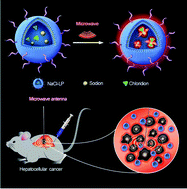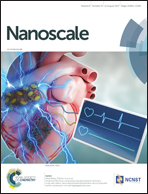Liposomes loading sodium chloride as effective thermo-seeds for microwave ablation of hepatocellular carcinoma†
Abstract
Microwave ablation (MWA) is a promising minimally invasive therapy that has been widely used to treat hepatocellular carcinoma (HCC). However, the efficiency of MWA in treating HCC is evidently limited by the incomplete ablation of large tumors and tumors in high-risk locations. Here, we report the value of using liposomes packed with sodium chloride (NaCl-LPs) as effective thermo-seeds for MWA of HCC. The prepared liposomes exhibited excellent heat conversion ability by showing a more rapid temperature increase than free NaCl medium, blank liposomes or water under microwave irradiation. The high efficiency of this new microwave sensitization strategy was fully demonstrated in vitro in subcutaneous and orthotopic tumors. The results showed that MWA combined with NaCl-LPs clearly enhanced the ablation efficiency, leading to apparent tumor inhibition and low recurrence. What's more, we verified the susceptibility of NaCl-LPs on orthotopic tumors. Based on the unique properties of NaCl-LPs, sublethal MWA was used to mimic the transitional zone, and large-scale necrosis was observed in tumors combined with NaCl-LPs. In addition, HE staining and blood hematology analysis revealed no noticeable toxicity of NaCl-LPs in vivo, which confirmed that NaCl-LPs possessed good biocompatibility. Conclusion: The effective nanoparticles could play a valuable role in enhancing the thermo-sensitizing effect of MWA for achieving better therapeutic efficacy.



 Please wait while we load your content...
Please wait while we load your content...